The Frontend Course Builder in Tutor LMS is an exceptional feature that enables instructors to create their courses directly from the frontend without needing to enter the backend WordPress panel.
The Frontend Course Builder is only available with the premium version of Tutor LMS. To use it, instructors can simply log into their Frontend Dashboard (found at: yourwebsiteURL.com/dashboard) and click on the “Add New Course” button.
Course Info

First up is the “Course Info” section. Here, you will find the following fields to add:
- Course Title: When creating your course, choosing an appropriate title is important. The title should accurately reflect the content of the course, so be concise and catchy. To help increase visibility, it’s also a good idea to include relevant keywords in the title.
- Course Slug: From this section, you can edit the Course Slug. This will appear in the URL after the final backslash. To increase the visibility of your course in search engine results pages, it’s important to make sure that the Course Slug is relevant, contains relevant keywords, and that each word is separated by hyphens.
- About Course: Use this field to give potential students a general idea of what they can expect from this course, such as what the course will entail, its learning objectives, a brief overview of the syllabi, and so on.
Course Settings
You can update basic course settings and content drip options from this section. Let’s explain both of these.
General
In this section, you have the ability to customize certain attributes of your course.

- Maximum Student: This field allows the user to specify the maximum number of students that can be enrolled in a course. Setting the “Maximum Students” to 0 means there will be no limit on the number of students who can enroll in the course.
- Difficulty Level: Difficulty level settings for course enrollment allow the instructor to categorize the course into different levels of complexity, making it easier for students to choose the right course for their skill level. The four main levels are:
- All Levels: This option indicates that the course is suitable for students of all skill levels, from beginners to experts.
- Beginner: This option is for courses designed for students with little to no prior knowledge of the subject. These courses are intended to provide a solid foundation for further study.
- Intermediate: This option is for courses intended for students who have some knowledge of the subject but want to deepen their understanding. These courses assume that students have a basic understanding of the subject and build on that knowledge.
- Expert: This option is for courses designed for students with a high level of skill and knowledge in the subject. These courses assume a high level of understanding and are designed to challenge students and help them develop their skills further.
- Public Course: The Public Course option is a setting that makes an online course available for anyone to enroll. This means that the course can be accessed by anyone who has the link to the course page, and they do not need to log in or have an account to view the course content.
- Q&A: This option allows Instructors to enable a Question and Answer section for the selected course.
Content Drip
Moreover, if you have the Content Drip add-on enabled (Pro Feature), you will find its settings in a new tab right below the General tab.
The “Content Drip” add-on (Pro Feature) allows instructors to release course content to students gradually over a specified period of time.
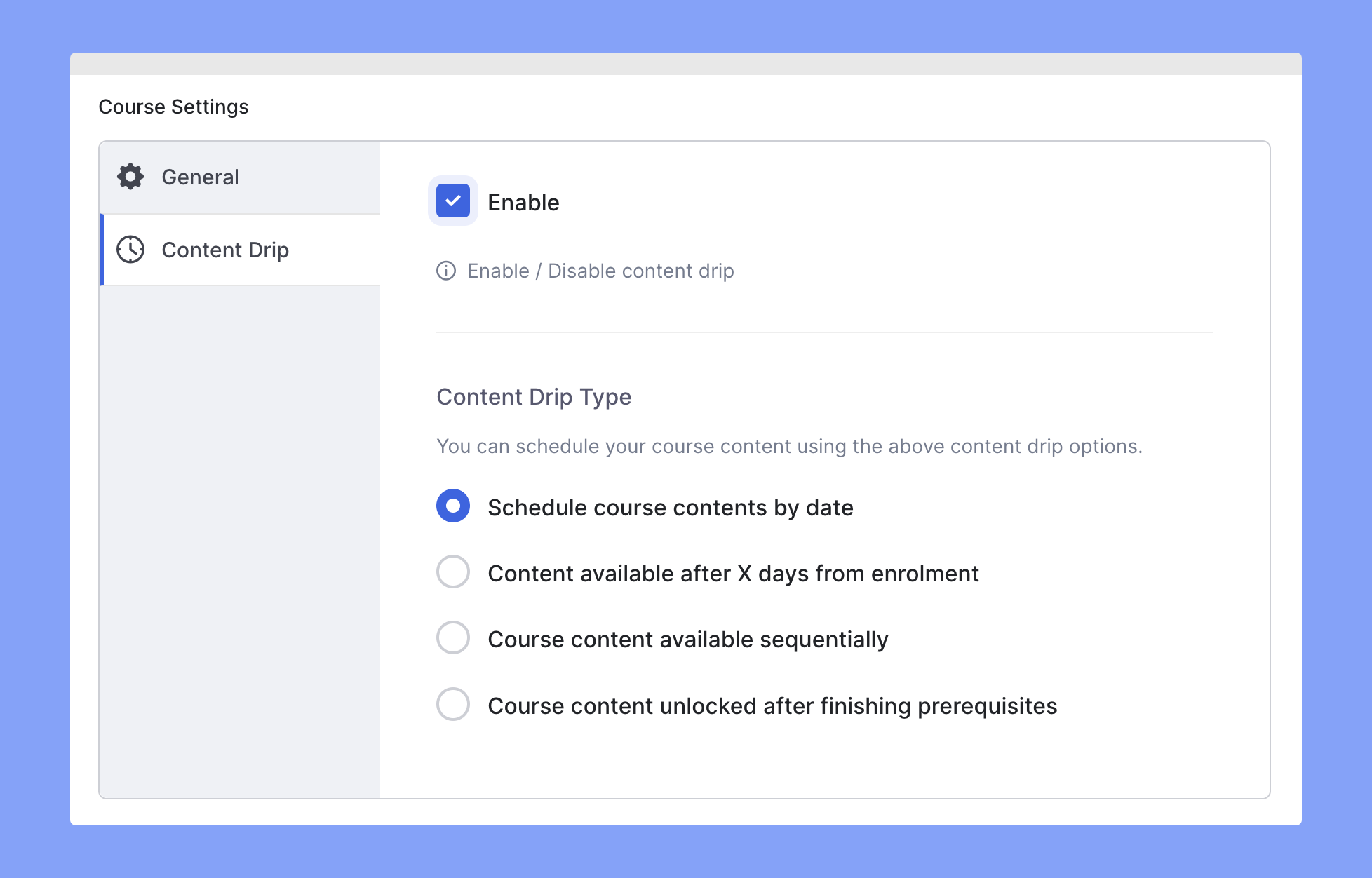
To learn about Content Drip and the various types of content scheduling options available in Tutor LMS, please visit our dedicated documentation.
Choose Course Category
The “Choose Course Category” option allows you to categorize your online course into specific topics or areas of study. This helps in organizing and grouping similar courses together, making it easier for students to search and find courses that are relevant to their needs.

You can add categories by navigating to WP Admin > Tutor LMS Pro > Categories.
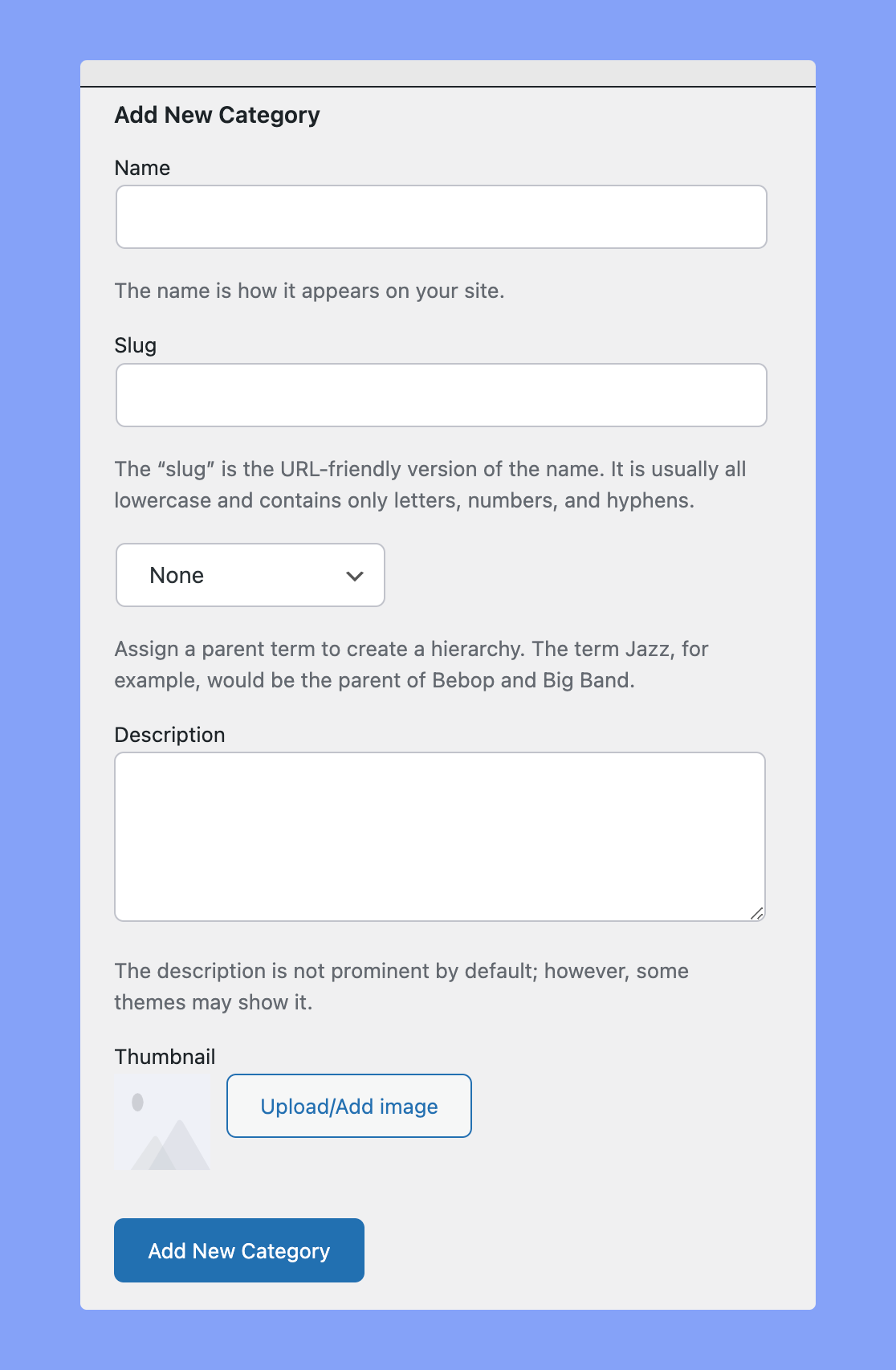
Set Course Price
The “Set Course Price” section allows you to choose whether the course will be free or paid. By the way, you have to use an eCommerce plugin and enable monetization on your website to get this section.

If the course is paid, you have the option to set both a regular price and a discounted price. This section allows you to determine the cost for enrolment in the course.
Tutor LMS supports WooCommerce, Money Management, Easy Digital Download, Paid Memberships Pro, WooCommerce Subscription, and Restrict Content Pro. To know more about these, please check our eCommerce documentation.
Set Course Thumbnail
The “Set Course Thumbnail” section allows the course creator to add a main image or visual representation for the course. This image will appear on the course listings, promotional materials, and other relevant pages. The purpose of the thumbnail is to make the course more visually appealing and to give potential students an idea of what the course is about.

Please make sure to follow the given instructions for the best results.
Course Intro Video
The “Course Intro Video” section allows you to add a video introduction to your online course that will appear on the Course Overview Page. You can choose from multiple video sources, such as HTML5, External URL, YouTube, Vimeo, Embedded, or Shortcode, to include the video in your course.
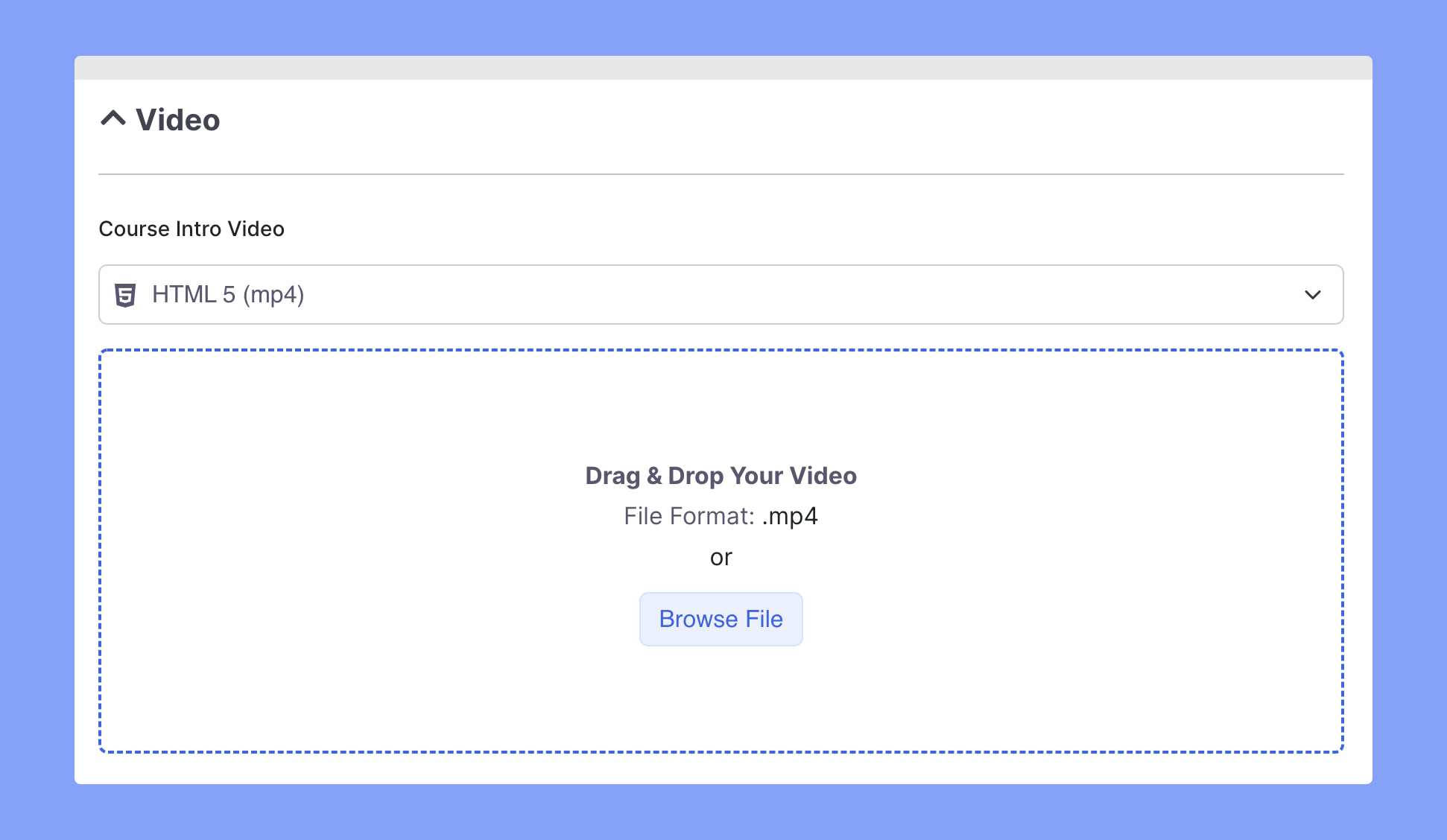
Note: Before proceeding, make sure to select your preferred video source(s) from the Tutor LMS Settings > Course section. If this step is not completed, the video sources will not be available in the dropdown list.
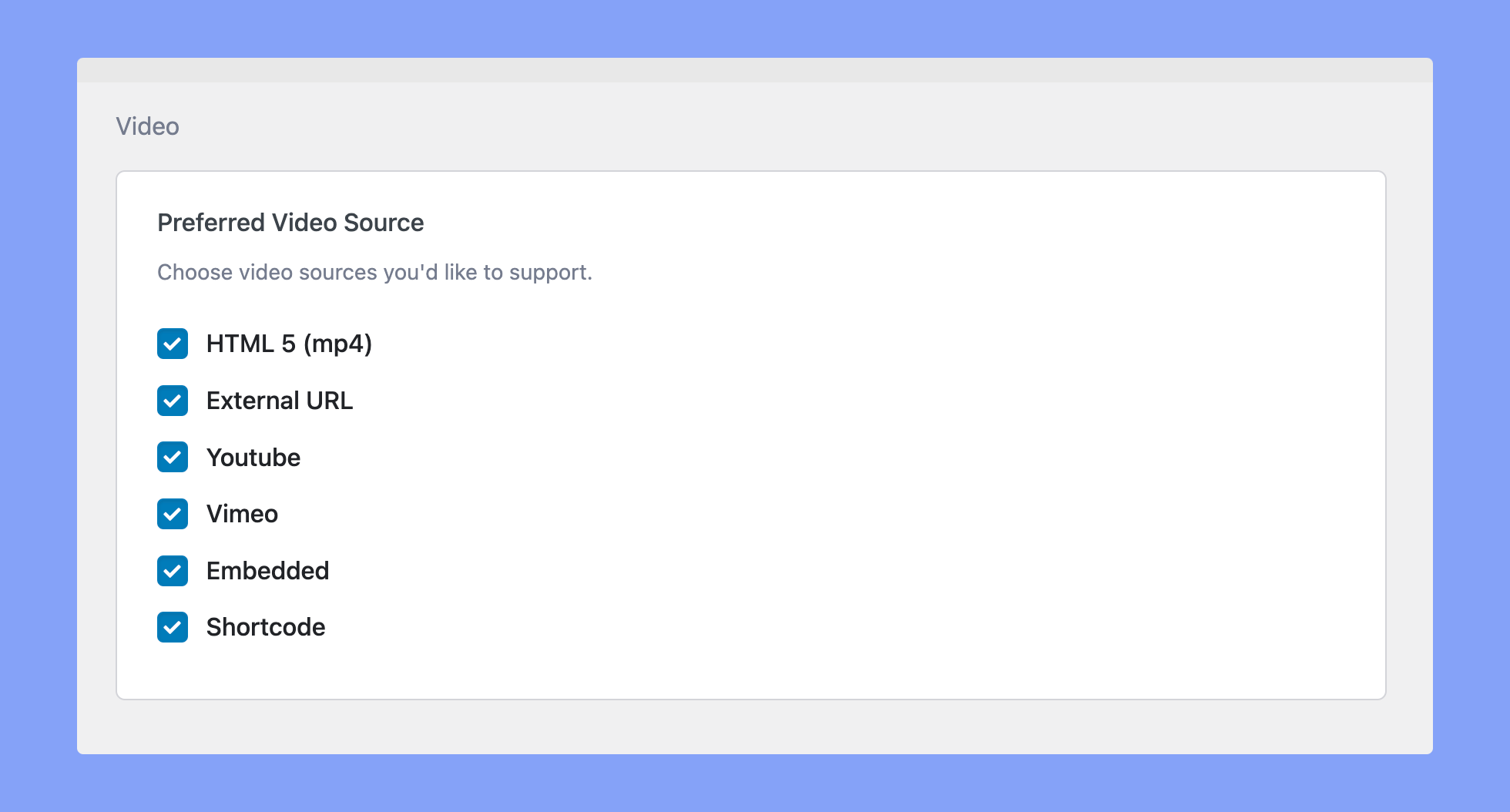
Course Builder
The “Course Builder” is the bread and butter of Tutor LMS. This allows the creation and organization of course content.
It provides a visual interface for managing your course content, including adding, editing, and organizing topics, lessons, and quizzes. You can also use this section to customize important course details such as information, settings, and attachments.
This section enables the instructor or administrator to easily build the structure and content of an online course and make it available for students to enroll and take.
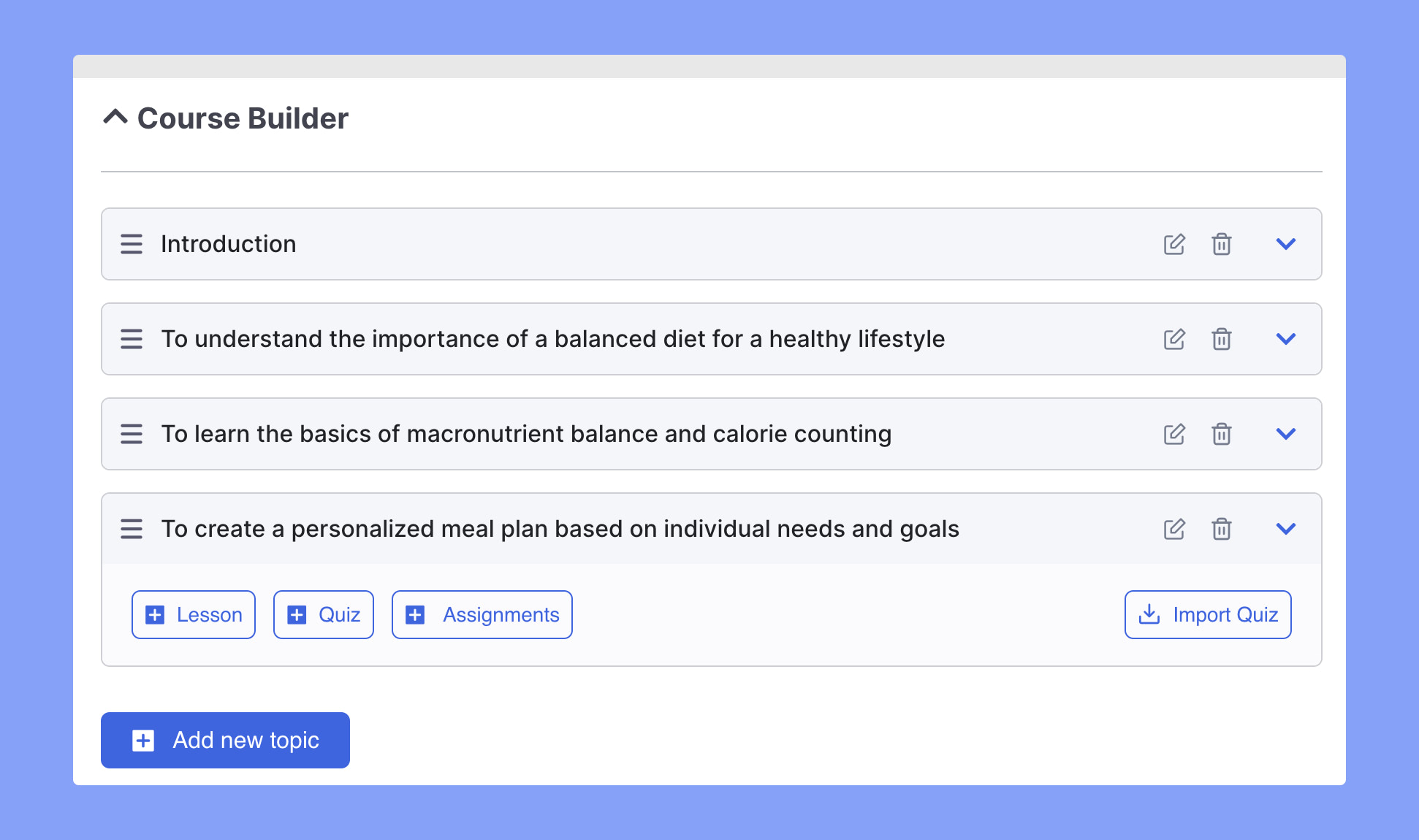
In Tutor LMS, the structure of a course is comprised of topics, and within each topic, there are lessons, quizzes, and assignments. Although multiple lessons and quizzes can be incorporated within a single topic, it is recommended to have 2 to 5 lessons and one quiz per topic for optimal results.
Add New Topic

The “Add New Topic” function allows you to easily create and organize your course content. Simply provide a name and brief summary for each topic, and use the buttons provided to add lessons and quizzes. The process is intuitive and guided by helpful tooltips, ensuring a smooth and streamlined experience.
Add Lesson
To add a new lesson, click on the “+Lesson” button.
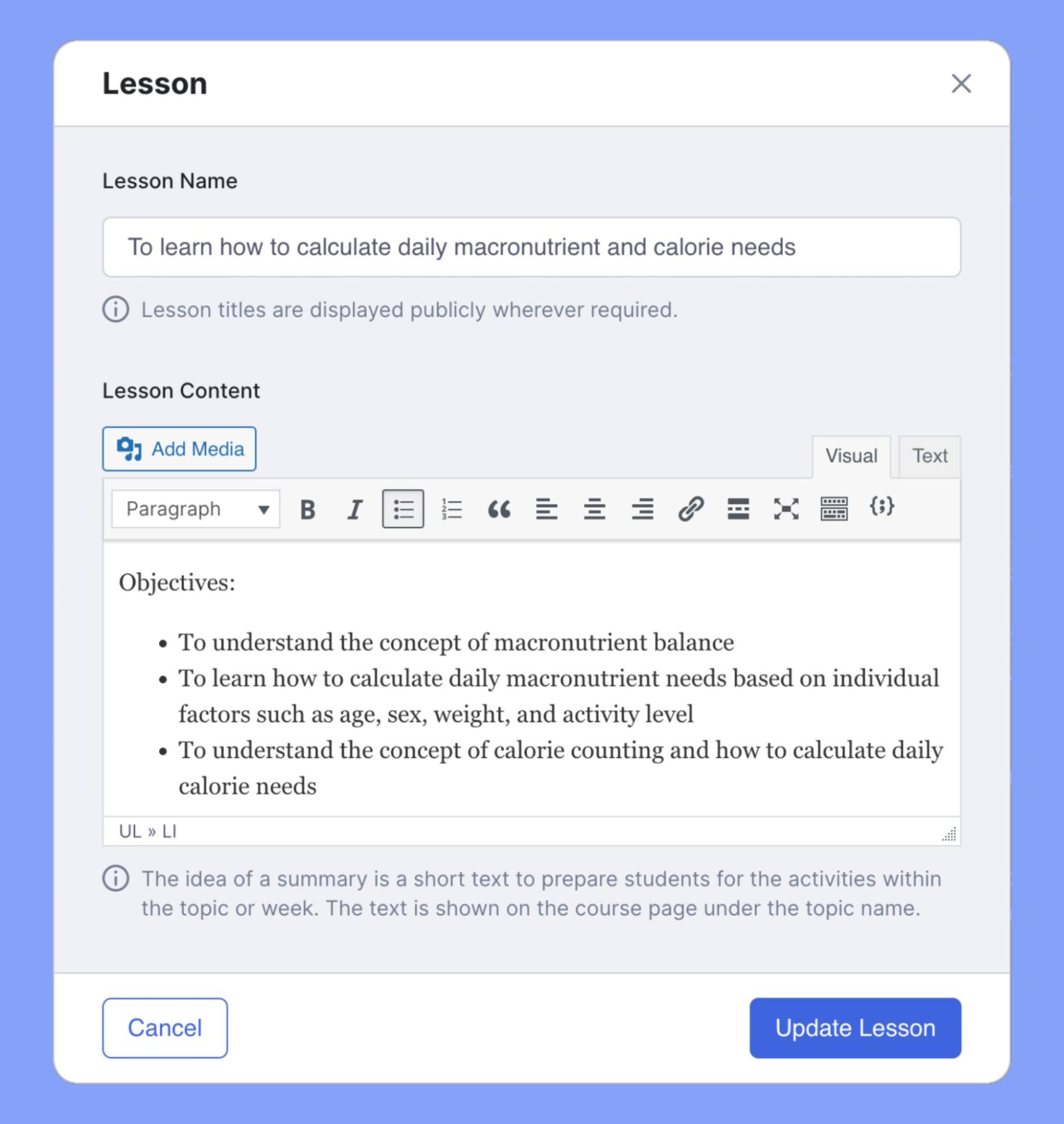
In the “Lesson” window, enter a title and description for the lesson and upload a featured image. Then, scroll down to find additional options such as Video Source, Upload Attachment, and more. These options are explained below:
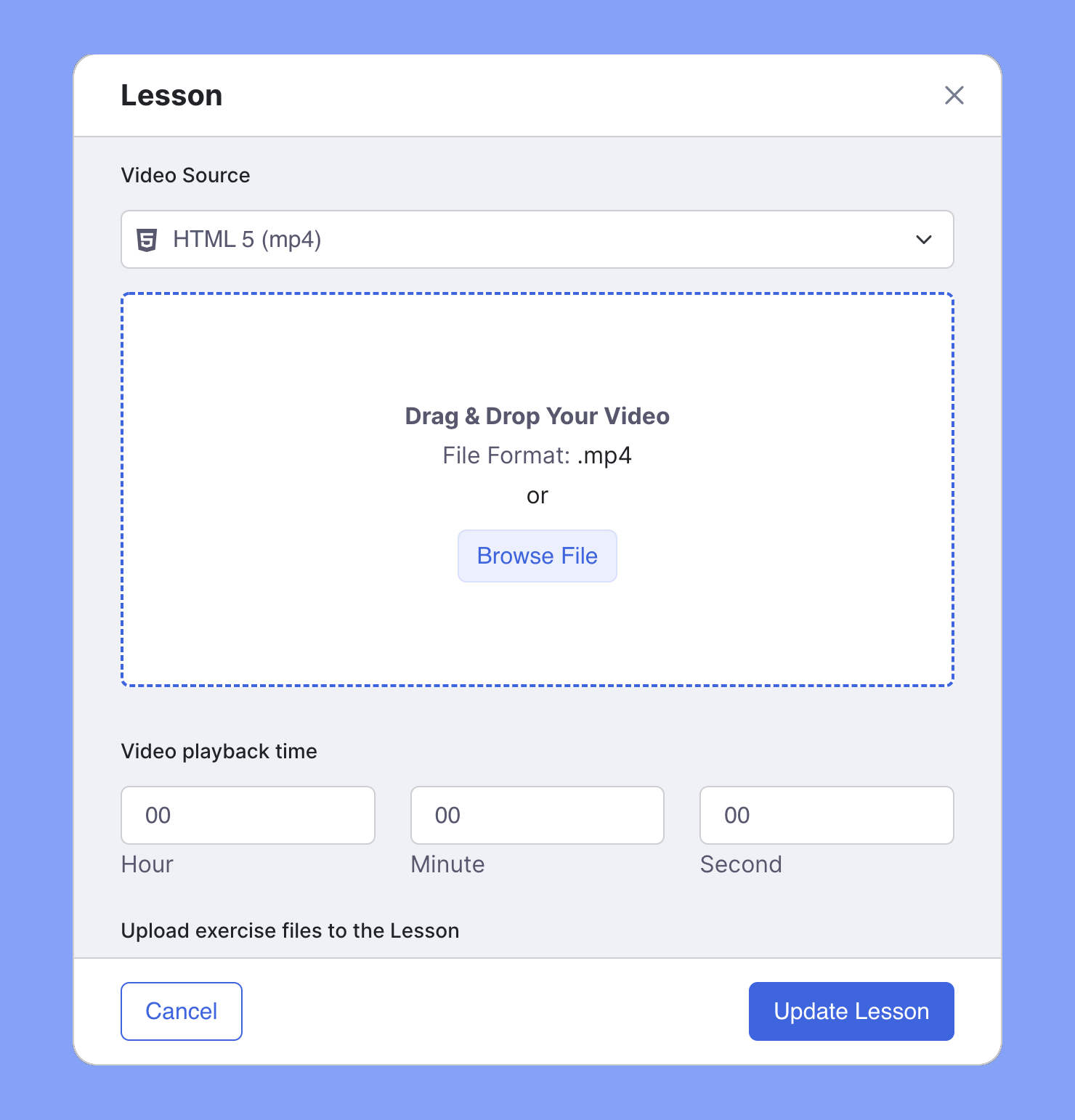
Video Source: You can add the source of the video lesson here. Similar to the Course Intro Video, you can choose from external or internal sources.
Video Playback Time: Specify the total playback time of the video in hours, minutes, and seconds. If the Video Source option is not available and you only see the message “No video source selected from settings!”, it means you need to select your preferred video source(s) from Tutor LMS Settings > Course.
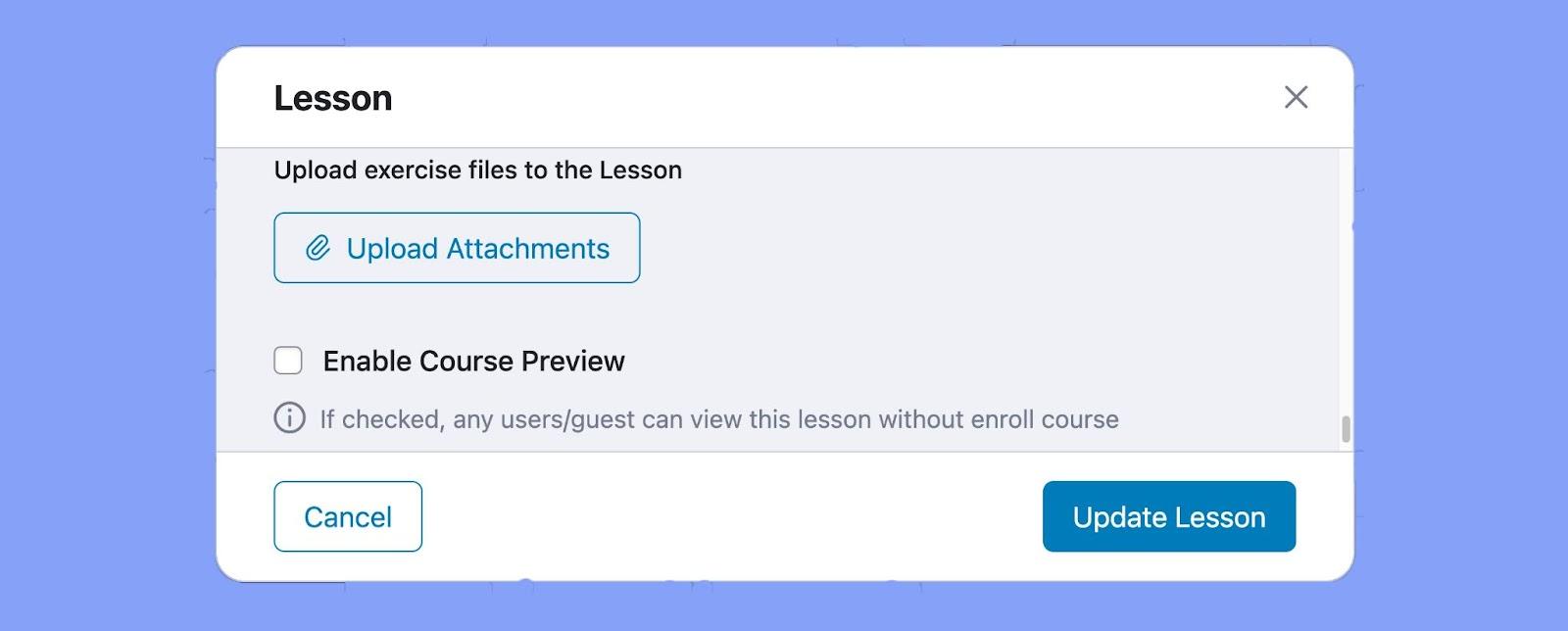
Upload Attachments: Upload any necessary materials for this lesson here.
Enable Course Preview: This option will only appear if the Course Preview add-on is enabled. For more information, refer to our documentation.
Add Quiz
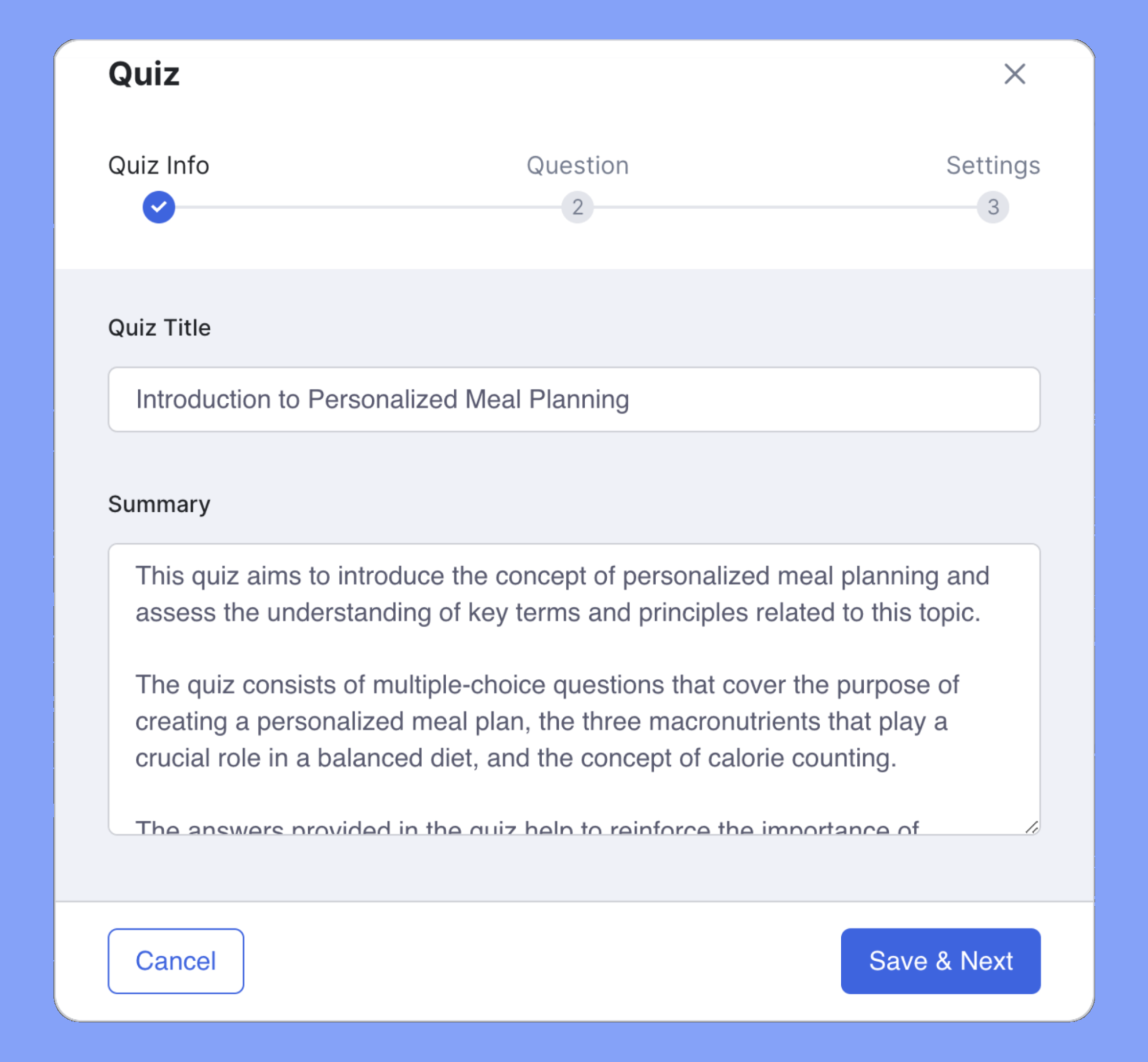
To create a quiz, click on the “+Quiz” button to open the Quiz Builder. However, Quiz Building is an extensive feature, so you’ll find detailed information on the process on its dedicated documentation page.
Import Quiz (Pro Feature)
You also have the option to export or import quizzes using the free Quiz Import/Export add-on available with Tutor LMS Pro. To learn more, please visit the documentation page here.
Add Assignments

Assignments are a Tutor LMS Pro feature, so if you have the add-on enabled, you can add Assignments to your courses by clicking on the “+Assignments” button. We discuss more on this topic in a more detailed documentation page.
Add Live Lessons
With Tutor LMS Pro, you have the ability to conduct Live Lessons as a pro feature. To do this, you must have a Zoom account and connect it with Tutor LMS. For further information on Live Lessons, please refer to the dedicated documentation.
Course Attachments
Course attachments are additional resources you may use in your courses. Such resources can include practice files, example files, and other important documents. You can upload these attachments here, and they will be available for students to download under the “Resources” tab on the Course Details Page.

Adding Instructors
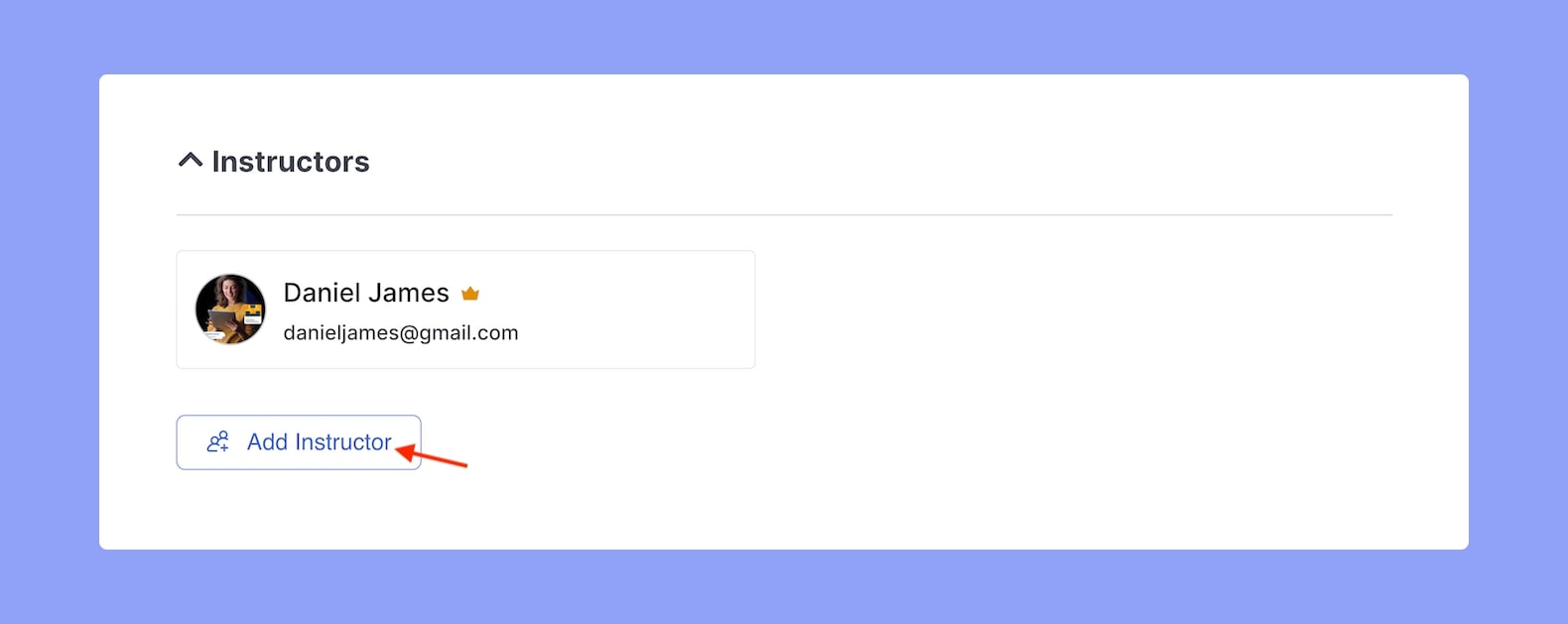
Being a pro user of Tutor LMS, you also have the privilege to assign more than one instructor to your course. To assign an instructor to your course simply click on Add Instructors option and search for them by name.
Additional Data

The following data acts as informative data for potential students while also acting as marketing material for your course.
What Will I Learn

List the knowledge and skills that students will learn after completing this course. (One per line)
Target Audience

Specify the target audience that will benefit the most from the course. (One line per target audience)
Course Duration

Specify the overall duration of the course, i.e. how long it will generally take for a student to complete this course.
Materials Included

A list of assets you or the instructors will be providing for the students enrolled in this course. (One per line)
Requirements

Add any additional requirements or special instructions for the students. (One per line).
Course Tag

Select related tags for this course. You can add tags from WP Admin > Tutor LMS > Tags.
Course Prerequisites

Prerequisites are designated courses that must be completed before accessing a specific course. These prerequisites are designed to ensure that students have the necessary foundation and understanding to successfully complete the course and receive maximum benefit from it.
For example, if you have two courses, “Basics of Programming Languages” and “Advanced Programming Languages,” you can set the “Basics of Programming Languages” as a prerequisite for the “Advanced Programming Languages” course, ensuring that students have a thorough understanding of the basics before moving on to more complex topics.
Note: Course Prerequisites is a Tutor LMS Pro feature, so you’ll have to enable the add-on from WP Admin > Tutor LMS Pro > Add-ons to use it. For more info, visit its dedicated documentation.
Certificate Template

In the Tutor LMS Course Editor, the Certificate Template section provides the ability to select a certificate template for students to receive after they have completed the course. This feature is only available if the Tutor LMS Pro Add-on for Certificates is enabled. To activate this, go to Tutor LMS Pro > Add-ons and turn on the Certificates option.
Additionally, you can create custom certificates by installing and activating the Certificate Builder Plugin, which is included with the Tutor LMS Pro package. For more information on this plugin, refer to its dedicated documentation.
Google Meet
Google Meet is another Tutor LMS Pro feature, so if you have the add-on enabled and set up, you can hold live lessons with this feature too. For more information about this add-on, please visit its own documentation page.
